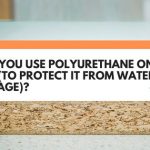MDF is an adaptable material that has a wide range of uses, from cabinetry to soundproofing.
However, MDF is far from a natural material. This wood composite has no grain texture to speak off.
And, as a manufactured wood, it is fairly plain to look at. But, its nothing that a coat of paint can’t fix.
Still, one of the more worrying aspects of working with MDF is the toxicity of this material. So, in this post, you will find out why freshly manufactured MDF is so toxic — while store-bought MDF is safe to use.
You will also learn what kind of an effect painting MDF has on it. And keep reading to discover which type of paint can be used on this engineered wood…

This post may contain affiliate links to products that we receive a commission for (at no additional cost to you). Learn more here.
How Harmful Is MDF? Or Do You Only Need To Worry About MDF Dust…
MDF sawdust is certainly worrisome, but it is only because of the fine glue particles in it.
You see, MDF is a type of engineered wood, and it is not a natural material. Rather, it is made up of densely packed wood strands bound together using a strong type of glue.
Now, the glue itself is the toxic part of MDF.
Inside that glue is a substance called Urea-Formaldehyde (UF), and it contains formaldehyde resins. Formaldehyde resin glues are used in the manufacture of a lot of engineered woods, such as Plywood and OSB.
Does MDF Really Have That Much Formaldehyde In It?
The glues often used to make this material certainly do. And formaldehyde is some pretty nasty stuff.
It is very hazardous whether it gets on our skin, or it becomes ingested. But, it is most deadly when it is inhaled.
This is why freshly manufactured MDF is much too toxic to be around.
So, after manufacture, this material needs to be left to dry out for months. This allows the glue time to completely set and stop off-gassing.
And What Is Off-Gassing?
Well, when solvent-based paints, glues, and finishes dry, they give off a strong smell.
That smell is the result of VOC’s (Volatile Organic Compounds) releasing into the air. And when VOC’s drift into the air, this is known as Off-Gassing.
However, VOC’s can continue to release for weeks, sometimes months, after that strong smell has faded. And Urea-Formaldehyde glue is no exception.
Formaldehyde glues can continue to off-gas for many, many months.
Now typically, this isn’t a problem. That’s because any reliable MDF manufacturer will always make sure this material dries first, before they ship it.
So, when you purchase MDF, it should no longer be off-gassing.
Is MDF More Toxic Than Plywood?
Yes, because a sheet of Plywood is much thinner and less dense than MDF.
MDF’s higher density means it requires more glue to bind together. As a result, MDF contains more formaldehyde resin-filled glue, (per square foot), than plywood.
And that’s the reason why MDF is more toxic than plywood.
That Sounds Dangerous…Is MDF Safe For Children’s Toys?
In theory, as long as MDF has been properly sealed and finished, (and stays that way), then it is safe.
In practice, as any parent knows, children’s toys can all too easily become broken — and sometimes even chewed. And if that happens, any seal around MDF can become broken. In which case, it’s no longer safe as a child’s toy.
In short, you likely shouldn’t use MDF to make any sort of toys for small children.
When Should You Not Use MDF? Don’t install MDF in a room that has a lot of moisture, steam, or splash-back. In other words, keep MDF out of the kitchen, bathroom, and laundry room.
What About After Painting? Is MDF Toxic When Painted?
Painting MDF doesn’t react with glue inside this wood. So, a few coats of paint won’t make MDF toxic.
Especially as MDF will have already been sealed with a primer prior to painting anyway.
But, if that paint were to somehow combust, then there are severe health risks associated with any smoke produced.
For example, some oil paints may contain Linseed oil, which is a substance that has a history of spontaneous combustion. So the combination of a possibly flammable paint and MDF, would be a bad one to say the least.
Otherwise, MDF is not inherently made more toxic by a few coats of paint.
Related Post: Can You Really Use MDF For Flooring (Or Is It A Bad Idea?)
What Happens When You Paint MDF? What Kind Of Paint Should You Use?
As long as you’re using a solvent-based paint, MDF will take on that coat of paint well.
However, if you’re using a water-based paint, such as acrylic paint, the water in it will become fast-absorbed. As a result, the paint won’t properly adhere onto the surface of MDF.
This is why you should generally avoid using water-based anything on MDF, whether it be a finish, sealer or glue. This moisture-wicking material doesn’t work well with water-based substances.
Should MDF Be Sealed Before Painting?
Ideally, it should. A quality primer sealer will waterproof and seal MDF. Although it should be applied on fairly thinly.
You can learn more about sealing MDF by checking out our post: MDF Or Plywood For Countertops: Which One’s Better For Your Kitchen?
In that post, we not only compare these two materials, we also dive into the best sealing primer you can use on MDF.
Do You Really Need To Seal MDF Again After Painting? If you want that coat of paint to last, you should probably seal it afterward too. But sealing after painting is more about protecting the paint, not about waterproofing MDF.
To Wrap Up, Here Are The 3 Key Takeaways From This Post…
- 1). MDF is a manufactured wood that contains Urea-Formaldehyde, which is a glue that contains formaldehyde.
- 2). The formaldehyde in MDF is toxic. Especially if it is inhaled either in the form of vapor or sawdust.
- 3). MDF is not toxic if it is both wholly dry and completely sealed.
References:
Comparison of results obtained by static 3- and 4-point bending and flexural vibration tests on solid wood, MDF, and 5-plywood | Degruyter.com
A solution to spontaneous combustion in linseed oil formulations | Science Direct



